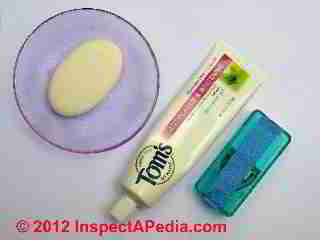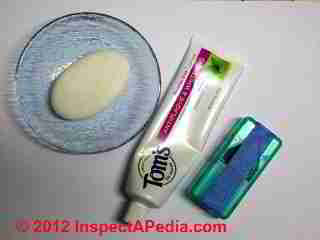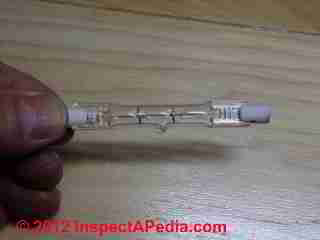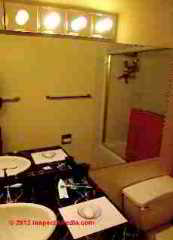 Light bulb (lamp) color
Light bulb (lamp) color
temperature & brightness compared & illustrated
- POST a QUESTION or COMMENT about about lamp or light bulb color temperature or brightness, applications, & uses.
Light bulb color comparison examples, photos:
LED & Halogen colors & brightness: this article describes the variations in perceived color and color temperature of different indoor-use bulb types compared with sunlight.
We illustrate both interior lighting bulbs (incandescent, three types of fluorescent bulbs, halogen lamps, and LED bulbs) comparing both color temperature (color rendition) and brightness.
We illustrate what different object colors look like under different types of lamps (bulbs) including incandescent, all types of compact fluorescent bulbs, halogen lighting, and LED lighting. We include comparisons of types of LED bulb brightness using flashlights for an example.
InspectAPedia tolerates no conflicts of interest. We have no relationship with advertisers, products, or services discussed at this website.
- Daniel Friedman, Publisher/Editor/Author - See WHO ARE WE?
Comparative Examples of Color Temperature and Color Rendering Index for Indoor Light Bulbs (lamps)
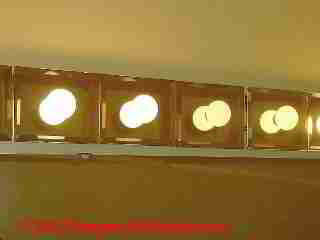 At COLOR TEMPERATURE & CRI for INDOOR LIGHTS we introduced and defined color temperature and CRI.
At COLOR TEMPERATURE & CRI for INDOOR LIGHTS we introduced and defined color temperature and CRI.
Here we provide additional details and photo examples of variations in perceived color and color temperature of different bulb types compared with sunlight.
We illustrate both interior lighting bulbs (incandescent, three types of fluorescent bulbs, halogen lamps, and LED bulbs) comparing both color temperature (color rendition) and brightness.
This article includes excerpts or adaptations from Best Practices Guide to Residential Construction (Steve Bliss, J Wiley & Sons) , by Steven Bliss, courtesy of Wiley & Sons.
Skin tones look best under lamps rated from 2700K (standard A-bulb) to 3500K and with a CRI over 80. Residential lamps range as high as 7500K for continuous spectrum fluorescents, such as GE’s Chroma 50 or 75.
These simulate daylight and are good for detailed work where color accuracy is critical, but they give skin an unflattering greenish tone.
We also discuss Halogen Lamp (light bulb) Color. emperatures & Properties. This is a photo guide to the effects of varying color temperatures of different light bulbs & lamps.
Halogen Lamp (light bulb) Color Temperatures & Properties. Comparing Light Output using LED Flashlights for an Example. Sorting out Definitions of Color Temperature of light, Light Brightness, Watts & the Wavelength of Light: What's the Difference? Table of Color
Temperatures of Various Artificial & Natural Light Source BULB COLOR TEMPERATURE
and CRI for Indoor Lights BULB CRI SCALE RATES & DEFINITION
Comparing the Appearance of Color Temperatures of Different Bulb Types
The display below, available at many Home Depot stores, compares lighting among four bulb color types, from left to right
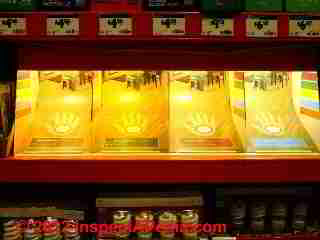
- Incandescent bulb
- Soft white compact fluorescent bulb
- Bright white compact fluorescent bulb
- Daylight compact fluorescent bulb
The accuracy of color rendition of different lights and the CRI scale are explained
at COLOR TEMPERATURE and CRI for Indoor Lights.
The four lamps (bulbs) described above are shown inside the display, below. We kept the camera on the same "automatic" white balance setting for all four bulb color photographs.
These colors are not exactly what your eye will see, nor do they consider the effects of the colors of surroundings, but you can see the color temperature differences among these light bulbs.
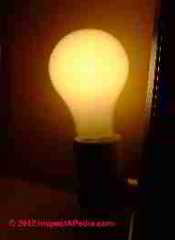

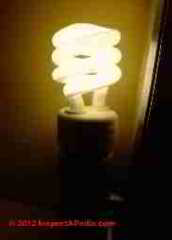
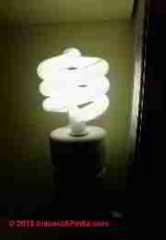
The display, which includes a spot for you to insert your hand to observe what each light does to the perceived color of your skin, also describes the applications for these bulb color temperatures (corresponding to left-to-right above) as:
- Incandescent - general purpose light source. Standard incandescent bulbs give off light at 2700o Kelvin and produced a reddish light that is best where comparatively low levels of light are desired. These bulbs produce the lowest frequency or color temperature compared with outdoor daylight which is described as 6500o Kelvin.
- Soft White - a warm full glow light ideal "lifestyle" light. Color corrected fluorescent bulbs operate at about 3600o K and skin tones look somewhat normal under these lights.
- Bright white - a crisp, white light ideal for kitchen and task areas.
- Daylight - simulates natural sunlight, ideal for reading & detail oriented activities. Full spectrum fluorescent bulbs operate at about 5000o K, producing lighting simulating daylight but with skin tones slightly greenish. Bliss points out that these lights are popular in art galleries & jewelry stores.
Watch out: if you didn't notice, the compact fluorescent bulbs such as the models shown above include a warning printed on the bulb base indicating that these bulbs are intended for dry locations, and are not for use in luminaires controlled by a dimmer or totally enclosed recessed lighting fixtures.
Check the specifications on lamps you are buying if you have other needs than those that fit these restrictions.
Photo guide to the effects of varying color temperatures of different light bulbs & lamps
Colors of Objects in Indirect Sunlight
Recognizing that the human eye does not see light and color exactly the same as any camera, film or digital, we set our camera to a white-balance setting based on white typing paper in indirect sunlight to begin the light color temperature comparison photographs shown here.
Each photograph was taken with a glass soap dish placed on plain white typing paper. The white balance of the camera was set to normal for the white typing paper alone, in sunlight.
We take the first soap dish color photograph as our reference standard, as this image was taken in outdoor sunlight.
At below left a string of eight (4 shown) mini globe incandescent bulbs give the glass soap dish a pink hue that is very close to the color we found in sunlight.
You can see that the soap dish as a very light pink-purple color in the reference photo. Actually outdoors, to the human eye, we saw this dish as more "pink" than did our camera.
Comparing Colors of Objects in Incandescent & Fluorescent Light Indoors
We set our camera white balance to the same white paper under incandescent lighting indoors (below left) and then for compact fluorescent bulbs in an overhead light fixture (below right).
You will observe that the indoor incandescent shifts the original image towards red/pink hues while the compact fluorescent lighting shifts the image towards blue-green.

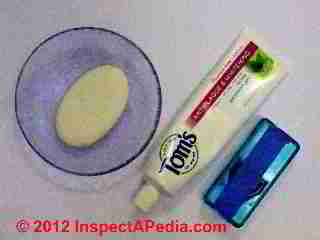
At below right we illustrate what these same objects look like under a standard (long tube) fluorescent lamp. Compare that photo (below right) with the compact fluorescent lamp lighting photo (above right) and you can see a shift towards green.
At below left we illustrate our darkroom test set-up for light source comparisons, in this case with a "blacklight" or UV ultraviolet light bulb (Woods lamp) installed in our test fixture using a 13W bulb produced by Feit Electric.[5] (280-410nm usually narrowed to 368-371 nm wavelength light).
Some septic system and building inspectors use UV lamps to detect the presence of septic test dye that contains fluroscein, or to screen for animal urine stains.
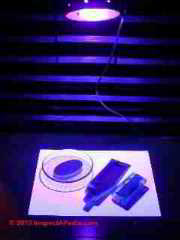
See UV LIGHT BLACK LIGHT USES for definitions of fluoresence, UV light, black light, and the use of UV lights in buildings to track down different substances including animal urine or even blood.
Also see BLOOD in ART WORKS, TESTING FOR.
Halogen Lamp (light bulb) Color Temperatures & Properties
As explained at explained
at Color Temperature and CRI for Indoor Lights,
the color rendering index (CRI) of light bulbs provides a scale of 1 to 100 where a bulb rated at 100 closely matches a reference light source.
Colors of Objects under a Halogen Lamp
Halogen lamps such as the bulb we show at below left operate at around 3000K and give off a whiter light than incandescents and most fluorescents.
Below we include an example photograph of our color references used above, but here, illuminated by a halogen lamp.
Comparing this result (below left) with our example from daylight (above) you will see that the halogen image is rendered rather close in color temperature to daylight.

- For incandescent lamps and all others with a color temperature of 5000K or less, the reference used to state the CRI of those bulbs is an incandescent or halogen bulb, which are both assigned CRIs of 100.
- For lamps with a color temperature of over 5000K, the reference is natural daylight, which also has a CRI of 100 or "perfect" color rendition.
Comparing Light Output using LED Flashlights for an Example
At LUMENS, DEFINITION, COMPARISONS we defined Lumens as
a measure of the amount of light contained within an area or within a defined beam or angle emitted from the light source. Lumens is further defined as the total amount of visible light emitted by a source.
Here we offer a more subjective comparison of the brightness of light emitted by LED bulbs, using flashlights as an example. Take a look at the rated light output in lumens when you can find that information.
It is both useful and very interesting. For example when purchasing LED-designed flashlights, you will usually observe that the very inexpensive units may look exactly like others that cost five to ten times as much.


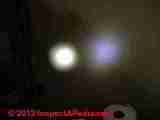
But the light output of the low-priced units is often 1/10th the light output of the costly versions. Brighter LED's cost more. And if the flashlight marketing information on the package does not tell you the light output of the device... well that tells you something, right?
And our digital camera "sees" light differently than the human eye - a fact that can add difficulties when photographing some subjects, as our three comparison photographs of light beams from two LED flashlights illustrate above.
All three photos are of the same two LED flash light units. But depending on external variables our eye and the camera see different brightness.
From left, with no flash the right-hand LED flashlight looks brighter shining on blue ceramic tile. With a flash to eliminate dark background, the bulbs look about equal.
With no flash and shining the two LED flashlights onto a darkened wall, the left-hand LED flashlight looks brighter (and less diffuse, which confuses the matter). [Click any image to see a larger version.]
Color Temperatures of Various Artificial & Natural Light Sources
As Bliss points out in COLOR TEMPERATURE & CRI for INDOOR LIGHTS, the comparison standards for color temperatures of lights produced by different types of lamps are not uniform. Quoting:
For incandescent lamps and all others with a color temperature of 5000K or less, the reference is an incandescent or halogen bulb, which are both assigned CRIs of 100. For lamps with a color temperature of over 5000K, the reference is natural daylight, which also has a CRI of 100.
CRI numbers are best used to compare lamps with color temperatures within about 300K of each other. Colors will look very different under a 3000K lamp and a 6000K lamp with the same CRI.
Sorting out Definitions of Color Temperature of light, Light Brightness, Watts & the Wavelength of Light: What's the Difference?
Do not confuse color temperature (in degrees Kelvin) with brightness. The table below describes color temperature (or you could say "hue", not the brightness of the light source.
- Color temperature - Kelvin: the color temperature of a light source (visible to humans) is the temperature measured in Kelvin of a theoretical idealized black-body radiator that emits light of a matching color hue to that of the light source we are actually observing.
Higher color temperature numbers in Kelvin (over 5,000 oK ) are cooler, more blue in hue.
Lower color temperature numbers (2,700-3,000 oK) are warmer or more red colors. Our table below gives the color temperatures of many types of light sources, both artificial and natural. - Light brightness - Lumens: We measure the brightness of light in Lumens or equivalents. Lumens is a measure of the amount of visible (to humans) light observed / measured within an area or within a defined beam or angle emitted from the light source. Lumens is further defined as the total amount of visible light emitted by a source.
One lumen is (at one steridian) equivalent to one candela in light intensity.
Typical narrative describes as a practical example that one "birthday cake candle" emits one lumen if its light is measured at a distance of one foot from the light source. - Visible light (to humans) - measured in wavelength: light visible to humans is a form of energy (or photos if you like) emitted in the 380-780 nanometer wavelength range. The wavelength of light and its color temperatures are inversely related.
That is, higher wavelengths (bigger numbers) are lower or cooler color temperatures. [9][13]- 7,831 oK = 370 nm wavelength light
- 6,585 oK = 440 nm wavelength light
- 6,300 oK = 460 nm wavelength light
- Formula: [Peak] light wavelength in meters [actually nanometers or nm] lambda Max = b/t where T= light temperature in Kelvin or oK and b = Wien's displacement constant of proportionality = 2.897 768 5(51) × 10–3 m K
- Color Rendering Index (CRI) is a rating on a scale of 1 to 100 of how accurately a lamp shows colored objects. The higher the CRI, the closer the colors look to a standard reference.
- Watts as a measure of light brightness
Because watts, the traditional standard of brightness of incandescent light bulbs no longer expresses the total light output of other types of bulbs (CFs and LEDs for example), we use lumens as a better measure of bulb light output.
Properly, watts are a measure of a rate energy conversion or transfer (one watt is defined as one joule per second) not specifically a measure of light output.
Table of Color Temperatures of Various Artificial & Natural Light Source
Light Source or Type |
Color Temperature in oK |
Comments |
| Match flame | 1,700 oK - 1850 oK | Very low color temperatures, more warm or red in hue. |
Candlelight - flame from a single candle |
2,000 oK | Candle flames are 1850-1930 oK. Some sources say 1,800oK Notes 2, 3 Sunrise/Sunset color temperature range is 2000 oK to 3000 oK |
| Horizon light (simulating daylight) | 2,300 oK | Note 4. |
| Standard incandescent bulb, 15-watt | 2,470 oK | Tungsten filament household bulb |
| Standard incandescent bulb, "soft white" |
2,700 oK to 2,800 oK | Living areas. Typical incandescent bulb color temperatures range from 2,700oK to 3,300oK (Incandescent tungsten filament household bulbs range from 2,470 to 2,900 oK depending on bulb wattage) |
| LED bulbs, Warm-White | 2,700 - 3,200 oK | Note 6. |
| Krypton bulb, 500W | 2,900 oK | |
Halogen bulb Soft white compact fluorescent bulb |
3,000 oK | Other sources rate halogens at 3,400 oK Note 3. |
| Projector type bulbs, filament | 3,100 oK | |
Photo floodlamps, studio lamps |
3,200 oK | Quartz lights range from 3,200 to 3,500 oK Tungsten 5k or 10k Lamps have a higher color temperature of 3380 oK 3,200 oK is a common reference color temperature for expressing RGB values used to simulate the colors of images captured on "indoor" photographic film. 6. |
| Studio "CP" light |
3,350 oK | |
| Halogen bulbs | 3,400 oK | |
| Fluorescent bulb, color corrected | 3,500 oK | Fluorescent light color temperatures range from 3,200 to 7,500 oK |
| "Bright white" bulbs | 3,500 oK - 4100 oK | Kitchens, bathrooms |
| Projector bulbs, carbon arc (traditional movie) | 3,900 oK | |
| Fluorescent bulb, cool white Moonlight (natural, full moon, clear night) Xenon arclamps |
4,100 oK | Some sources put moonlight at 4,200 oK 3. |
| Cool white fluorescent "store lights" | 4,150 oK | Note 4. |
| LED bulbs, "Natural White" | 4,000 - 4,500 oK | Note 6. |
| Daylight, with industrial smog conditions | 4,700 oK | Note 3. |
Cool White or "Daylight" CF bulbs |
5,000 oK | Fluorescent lamps rated as "artificial daylight" have color temperatures of 5,000 oK or 7,500 oK Note 4. Noon sunlight range: 5,000 5,400 oK |
| Dayligt (sunlight) under hazy conditions | 5,100 oK | Color temperatures over 5,000 oK are considered cool colors and are more blue-white in hue. Sunlight through clouds or thick haze range from 5,500 to 6,500 oK Notes 2, 3. |
| Daylight - sunlight Electronic flash (cameras, pocket) |
5,500 - 6,100oK | Sunlight at 30 deg. over the horizon is typically 5,500 oK while sunlight at 50 deg. over the horizon may be 6,100 oK. Daylight ranges given as 5,500 to 6,500 under a clear sky Electronic flash from larger photo-flash devices may be rated at 6,700 oK 3. |
| Daylight: sunlight at mid-day | 6,500 oK | Whitest light. Some sources rate this as "overcast light" 2 |
| Fluorescent bulb, "daylight" rated | 6,500 oK | Reading, close-work |
| Daylight (sunlight) through overcast sky or in indirect light | 6,500 oK - 7,500 oK | More blue than sunlight. Some sources put overcast sky daylight at 7,400 oK 3. |
| Electronic flash (cameras) | 6,700 oK | Note 3. |
| LED bulbs (lamps), "cool-white" | 7,000 - 7,500 oK | Note 6. |
| Daylight (sunlight) measured in a shaded area | 7,000 - 8,000 oK | |
| Daylight (sunlight) measured under a partly clouded sky | 8,000 - 10,000 oK | Note 6. indicates that a cloudy sky is about 6,000 oK |
| Daylight: foggy conditions | 8,300 oK | Note 3. [further study needed-Ed.] |
| Computer monitors, LCD or CRT screens | 6,300 - 9,300 oK | Note 2. Adjustable on many devices. Most RGB monitors, measured by examining a white point, are 6,500 - 7,000 oK |
| Sunlight, 5 Meters under water, near the equator | 14,000 - 20,000 oK | Note 5. |
Notes to the table of light source color temperatures
1. Also see Table 5-23, "Color Temperatures of Common Lamps" found in Lamp & Bulb Abbreviations & Type
2. cf reference [9] at the end of this article.
3. cf reference [10] at the end of this article. The Kelvin color temperatures offered by this source and included among those in our table above may involve both accurate measurements and some subjectivity about the actual weather conditions at the time, such as
"hazy" or "industrial smog" that would require more careful definition. The color temperatures of most common sources of visible light range from 1,800 to 160,000 oK
4. cf reference [11] at the end of this article.
5. cf reference [12] at the end of this article.
5. cf references [14] [16] [17] at the end of this article.
6. Seesmart, "How to Choose the Right LED Lighting Product Color Temperature", Seesmart, 4139 Guardian St., Simi Valley CA 93063, Tel: 805-578-2536, retrieved 2016/04/17, original source: http://www.seesmartled.com/pdf/kb/
AN002_How%20to%20Choose%20the%20Right%20LED%20Lighting%20Product%20Color%20Temperature.pdf
7. Also see FLUORESCENT LIGHT BULB TYPE
8. Also see FLUORESCENT LIGHT BULB COLOR TEMPERATURE
Reader Question: What are ANSI-coded light bulbs (lamps) & where can I find a table of the ANSI bulb codes?
I have heard of ANSI coded bulbs but do I need to worry about these codes? Where can I find what the ANSI bulb codes mean? - Anon. 5/14/12
Reply:
ANSI (American National Standards Institute) codes for light bulbs[8] permit a standard definition for bulb shape, design, electrical connections, light output, and other parameters. ANSI has defined approximately 100 bulb codes, typically 3-letter designations such as
- BAB (BAB Light Bulb - MR16 20W 12V Flood Halogen Open Face)
- DYS (DYS 120V 600W Projector Light Bulbs)
- ESD (ESD 120V 150W Projector lamp)
- FTC (FTC MR11 12V 20W Narrow Flood- front glass covered, Halogen bulb)
- etc. - more than we want to try listing here.
Many bulb (lamp) producers and distributors provide an extensive index to lamps by ANSI bulb codes and bulb types or applications. Perhaps because ANSI standards are sold you won't find it easy to obtain the details of most ANSI standards at ANSI's own website. A website that does an excellent job of illustrating the various ANSI bulb codes, bulbstock.com explains:
ANSI (American National Standards Institute) coded light bulbs meet specific industry standards for light output, bulb shape, base type, beam spread and other lamp specifications. If a manufacturer offers a light bulb with an ANSI designation, that bulb should be identical to a similarly ANSI designated bulb from other manufacturers. [7]
...
Continue reading at BULB COLOR TEMPERATURE U CRI or select a topic from the closely-related articles below, or see the complete ARTICLE INDEX.
Or see
Or see these
Recommended Articles
- BULB & LAMP TYPES GUIDE - home
- ANTIQUE & OLD ELECTRICAL RECEPTACLES
- ANTIQUE LAMPS (BULBS) & CONNECTOR TYPES
- ANTIQUE LAMPS (BULBS) LIGHT OUTPUT - LUMENS
- BAYONET BASE BULB TYPES
- BULB & LAMP ABBREVIATIONS & CODES
- BULB COLOR TEMPERATURE COMPRARISONS
- BULB COLOR TEMPERATURE U CRI
- BULB CRI SCALE DEFINITION & RATES
- COMPACT FLUORESCENTS INDOORS
- FLUORESCENT LIGHT BULB CODES & TYPES
- FLUORESCENT LIGHT REPAIRS
- FLUORESCENT vs INCANDESCENT BULBS
- HALOGEN LIGHTS INDOOR USES
- INCANDESCENT BULB GUIDE
- LAMPS (BULBS) ANTIQUE CONNECTOR TYPES
- LED BULB & LIGHTING TYPES
- RECESSED & TRACK LIGHT BULB GUIDE
- LIGHTING, INTERIOR GUIDE
Suggested citation for this web page
BULB COLOR TEMPERATURE COMPRARISONS at InspectApedia.com - online encyclopedia of building & environmental inspection, testing, diagnosis, repair, & problem prevention advice.
Or see this
INDEX to RELATED ARTICLES: ARTICLE INDEX to BUILDING LIGHTING
Or use the SEARCH BOX found below to Ask a Question or Search InspectApedia
Ask a Question or Search InspectApedia
Try the search box just below, or if you prefer, post a question or comment in the Comments box below and we will respond promptly.
Search the InspectApedia website
Note: appearance of your Comment below may be delayed: if your comment contains an image, photograph, web link, or text that looks to the software as if it might be a web link, your posting will appear after it has been approved by a moderator. Apologies for the delay.
Only one image can be added per comment but you can post as many comments, and therefore images, as you like.
You will not receive a notification when a response to your question has been posted.
Please bookmark this page to make it easy for you to check back for our response.
IF above you see "Comment Form is loading comments..." then COMMENT BOX - countable.ca / bawkbox.com IS NOT WORKING.
In any case you are welcome to send an email directly to us at InspectApedia.com at editor@inspectApedia.com
We'll reply to you directly. Please help us help you by noting, in your email, the URL of the InspectApedia page where you wanted to comment.
Citations & References
In addition to any citations in the article above, a full list is available on request.
- In addition to citations & references found in this article, see the research citations given at the end of the related articles found at our suggested
CONTINUE READING or RECOMMENDED ARTICLES.
- Carson, Dunlop & Associates Ltd., 120 Carlton Street Suite 407, Toronto ON M5A 4K2. Tel: (416) 964-9415 1-800-268-7070 Email: info@carsondunlop.com. Alan Carson is a past president of ASHI, the American Society of Home Inspectors.
Thanks to Alan Carson and Bob Dunlop, for permission for InspectAPedia to use text excerpts from The HOME REFERENCE BOOK - the Encyclopedia of Homes and to use illustrations from The ILLUSTRATED HOME .
Carson Dunlop Associates provides extensive home inspection education and report writing material. In gratitude we provide links to tsome Carson Dunlop Associates products and services.


